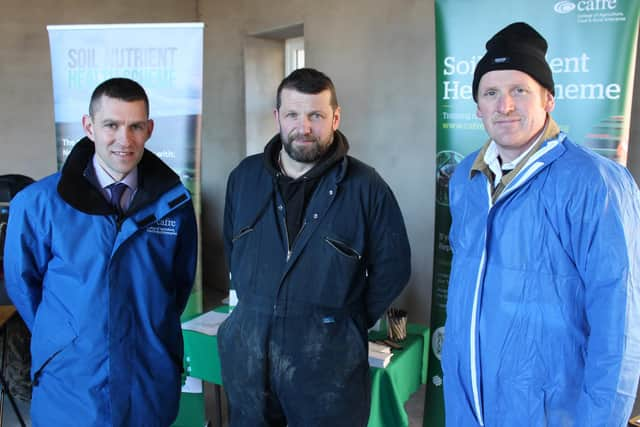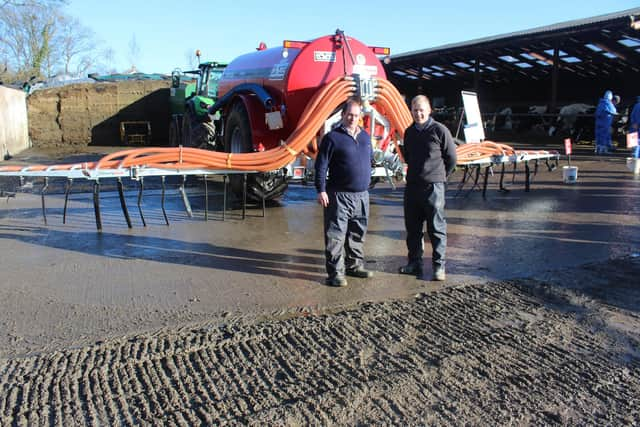Slurry management: getting the priorities right
and live on Freeview channel 276
The focus of this activity was the hosting of two slurry management events, one of which was held on the Banbridge dairy farm of Ian McClelland.
Mark Scott, Head of CAFRE’s Sustainable Land Management Branch, used his presentation at the Co Down venue to highlight the absolute of importance for farmers in getting the best possible value from all animal slurries.
He explained:
Advertisement
Advertisement


“There are four key sustainability challenges coming up for farmers. These relate to phosphorous, nitrates, ammonia and carbon.
“Slurry management and how farmers devise their future nutrient management plans will have a strong influence on all these issues into the future.
“Ammonia emissions from slurry can be controlled by the use of low emission spreading equipment.”
Where phosphorous is concerned, the issue is very much focussed on the run-off of slurry into water courses. And the same principle holds when it comes to reducing the level of nitrate ending up in our rivers and lakes.


Scott continued:
Advertisement
Advertisement
“Low emission spreading equipment will also reduce the amount of greenhouse gas emissions associated with the spreading of slurry. And, of course, this is clearly linked to the carbon agenda
“Slurry management has such an integral impact on each of these four, key sustainability challenges that now is an appropriate time to deliver a comprehensive update to farmers on this important issue.”
Where low emission slurry spreading is concerned, the CAFRE representative highlighted the growing use of the technology in Northern Ireland.
“All contractors must now use this form of equipment,” he further explained.
Advertisement
Advertisement
“And the same principle holds for farmers managing 200 livestock units and above. So the vast majority of slurry now goes out using either a dribble bar or trailing shoe.
“We are also seeing a lot of contractors using low emissions spreading equipment with umbilical systems.
“This is also very positive.”
Significant numbers of farmers in Northern Ireland have availed of grant aid to purchase new vacuum slurry tankers in tandem with a trailing shoe or dribble bar.
However, it is important that they calibrate these systems properly to ensure that actual slurry application rates are in line with a specific crop requirement.
Mark Scott again:
Advertisement
Advertisement
“Operators must take full account of the spreading capacity generated by all of the pipes, the band width of the system and the forward speed of the tractor.
“It’s important that farmers focus on application rates and how this stacks up with the actual nutrient requirement of the crops they are growing.”
According to Scott, tractors drawing a tanker fitted with a dribble bar or trailing shoe should be driven at faster speed in the field relative to what would have been the case if a splash plate-based system had been in use.
He further explained:
“Most farmers who have bought a new slurry tanker over the past five to seven years would have secured a machine that had been specified for the future attachment of either a dribble bar or trailing shoe.”
Advertisement
Advertisement
Turing to the issue of slurry capacity on livestock farms in Northern Ireland, the CAFRE representative indicated that the issue very much hinges on the weather at the shoulders of the year: late autumn and early spring.
“By law, farmers must have access to at least 22 weeks’ slurry capacity,” said Scott.
“Farms are randomly inspected by the Northern Ireland Environment Agency to ensure these standards are being maintained.
“But the more slurry storage a farmers has the better that business can meet the needs of a nutrient management plan.
Advertisement
Advertisement
“If farmers are not under pressure to get slurry out at the end of January, it then means they can spread this valuable nutrient at those times that best meet the needs of a growing crop.
“Slurry can be used in arable situations, if it can be feasibly integrated into the management of the growing crop.
“The priority for all farmers is to best integrate the use of slurry into the management of all the crops they grow: arable and grass.”
Slurry application rates
CAFRE has devised a two step calculation, which will allow farmers and contractors work out the required forward speed of a tractor when using a low emission slurry spreading system.
Advertisement
Advertisement
The variable to be included are the actual application rate required, the capacity of the tanker being used, the width of the trailing shoe or dribble bar and the estimated time to empty the tanker.
A standard example of this process would centre on an application rate of 3000gal/acre (33 m 3 /ha) using a 3000gallon (13.5 m 3) low emission spreading tanker, with a bandwidth of 7.5m: emptying in 4 minutes.
Step one of the calculation involves the volume of the tanker being divided by the projected emptying time (in seconds) to give a projected discharge rate.
In terms of the example referenced above, this works out at 0.056 m 3 /sec.
Advertisement
Advertisement
The required forward speed of the tractor is then calculated by multiplying the discharge rate by 36,000 and then dividing this figure by the product of the systems band with in metres and the application rate in m 3 /ha.
The final answer for the example given above works out at 8km/hr.
The two calculations can be summarised as follows:
Step 1: 13.5/4x60...........answer: 0.056m 3 /sec
Step 2: 0.056x36,000/7.5x33.............answer: 8km/hr
The benefits of slurry separation
The benefits of slurry separation were also profiled at the recent (CAFRE) events, hosted to highlight the value of all animal manures.
Research scientists at the Agri-Food and Biosciences’ Institute (AFBI) have assessed the most feasible way of separating slurry and, in addition, how to best utilise the liquid and solid fractions produced.
Advertisement
Advertisement
Driving this work is the growing recognition that slurry can be used in myriad ways to optimise crop growth.
AFBI’s Gary Lyons attended the slurry management event, hosted by CAFRE on the Banbridge dairy farm of Ian McClelland.
“The main driver of our research is to use mechanical separations in ways that allows for the better use of phosphorous in both slurry and the digestate produced from anaerobic digestion systems,” Lyons explained
“It is possible to remove some of the phosphorous contained in the solid fraction of these materials through a mechanical separation process.
Advertisement
Advertisement
“As a result, there is less phosphorous in the separated liquid fraction.”
He continued: “If there is less phosphorous going out into fields that are already high in phosphorous, this means that less of the nutrient subsequently escapes into water courses.
“Driving improvements in water quality is the focal point of our work, looking at the mechanical separation of slurry.”
According to the AFBI representative, the environmental challenges associated with the algal blooms that developed on Lough Neagh last summer epitomise the problems associated with water quality in Northern Ireland at the present time.
Advertisement
Advertisement
But Lyons also admitted that agriculture is not solely to blame for deteriorating water quality standards.
He further explained:
“Approximately 65% of the phosphorous entering Lough Neagh is coming from agriculture. The remainder is accounted for by domestic sources.”
Worryingly, research scientists do not know how long it will take mitigating measures to bring water quality standards in places like Lough Neagh back into balance.
Gary Lyons again:
“What is clear is the need to start doing something about the problem now.”
Advertisement
Advertisement
Lyons believes that is financially feasible for most livestock farmers to invest in a screw press separation system.
“They have been grant aided by the department of agriculture in the past.
"And, given current circumstances, I see no reason why investments in this form of technology would not be supported in the future,” he said.
Slurry separation and management systems are being developed by AFBI on the basis that the solids are not put back onto the farmer’s land.
Advertisement
Advertisement
“The plan is the export the phosphorous in the solids off the farm,” Lyons further explained.
“So, for example, separated slurry solids can be added to the feed stock used in an anaerobic digestion or biogas plant.
“Slurry solids are regarded as concentrated energy sources in this context.
“But subsequent to the digestion process, there would be a requirement to separate out the slurry solids.”
Advertisement
Advertisement
Lyons points to the fact that separated digestate fibre can be applied as a valuable phosphorous source on tillage crops.
“This is already happening,” he confirmed.
“It is also possible to dry slurry and digestate solids. Pelletting of the solids is also an option at that stage.
“An AFBI team is currently looking at the option of using these pellets as a solid fuel source.
“They have about 90% of the energy value contained in commercial wood pellets.
Advertisement
Advertisement
“However, the pellets would not be suitable for domestic use: they have high particulate gaseous emissions.
“However, they would be totally suited for use in power stations.”
Currently, agriculture in Northern Ireland is generating a phosphorous surplus of around 6,000t annually.
This reflects the phosphorous imported in feed and fertiliser relative to total crop requirements.
Advertisement
Advertisement
“The plans is to take as much of this surplus as possible out of agriculture altogether,” commented Lyons.
“This includes the sending of slurry solids to tillage areas in the Republic of Ireland.
“We are already supplying slurry solids generated at AFBI’s Hillsborough research farm in Co Down to neighbouring arable farmers.
“The material is accompanied by a full nutrient analysis of the material provided.
Advertisement
Advertisement
“A full record of the slurry solid exports generated is also maintained.”
AFBI has carried out trial work using both screw press and decanter centrifuge separation technologies installed at its Hillsborough-based farm nutrient management centre.
The research examined capital and operating costs, separation efficiency and throughput, the use of chemical additives, management and processing of separated fractions including transport costs, environmental impacts and the biosecurity of separated solids for export.
Of the two technologies reviewed, screw press separation is a more cost effective option when lower amounts of export of phosphorous off-farm are acceptable.
Advertisement
Advertisement
For farms and those with anaerobic digesters managing larger volumes of manure/digestate, screw press separation is possible.
However if higher levels of phosphorous removal are required, the use of decanting centrifugation is a viable option.
Centralised processing facilities could also make use of decanter centrifuge technology to act as processing hubs for a number of local farms within a distance that makes it economical for transport of slurry/treated slurry to/from the processor.
The Agri-Food and BioSciences Institute (AFBI) is a leading provider of scientific research and services to government, non-governmental organisations and commercial organisations. AFBI is sponsored by it’s key stakeholder, the Department of Agriculture Environment and Rural Affairs (DAERA). Customers include a range of local, national and international commercial companies, Northern Ireland and UK Departments, Agencies and associated bodies in the European Union.